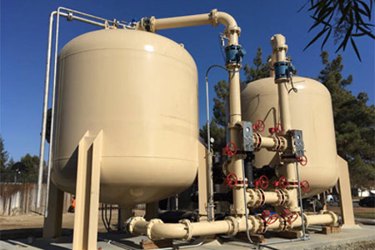The Effects Of Water Quality On Arsenic Removal

When considering an arsenic treatment option for a water system application, it’s important to obtain and review the proposed design criteria carefully. A good system design will have evaluated critical water quality parameters such as pH alongside arsenic, phosphate, silica, iron and manganese, vanadium, sulfide, and other heavy metal concentrations.
There are several heavy metals that exhibit similar chemical properties to arsenic. Generally, their effects are minimal as the concentrations present in the water are very low. However, if these concentrations are higher than arsenic, there may well be a reduction in treatment performance. Some of the key heavy metals that should be considered are vanadium, selenium, antimony, and nickel.
Phosphate is also of concern. Chemically, phosphorus in water behaves very similarly to arsenic. Phosphorus and arsenic are very close on the periodic table of elements, and so molecular shapes, ionic charges, and properties are similar in the same conditions. Phosphorus is more abundant than arsenic and generally appears at higher concentrations and can compete with arsenic during the removal process.
Silica needs to be considered. It interferes with arsenic removal in the adsorption process. Iron-based media can act as the nucleation point for the silica in the water and cause it to polymerize. When this happens, the polymerized silica physically blocks some of the pores of the porous media, making these active sites unusable. As a result, the capacity of the media will be reduced. It is possible to alter the water chemistry to negate this effect if the analysis is provided during the design stage.
Other water quality parameters to consider include pH. Arsenic changes its behavior, both the ionic charge and the molecular shape, depending on the pH value, which will consequently impact the effectiveness of arsenic removal from water.
Finally, some of the other critical considerations for utilities during the arsenic treatment selection process are hydraulics, footprint and infrastructure limitations, capital and operating costs, wastewater management and permitting, and the dependence on a skilled operator.
Ways To Treat Arsenic
Once you understand the water quality and hydraulic parameters of your treatment site, you can move forward in selecting the best treatment technology for your arsenic removal system. There are several options:
Adsorption: In the adsorption process, contaminants break their bond with the water molecules and chemically adhere to a filter media. This is accomplished by directing the water flow through pressure vessels that contain the adsorptive media at a specific rate that allows just the right contact time for effective adsorption to occur. AdEdge Water Technologies’ Bayoxide E33 is a widely accepted adsorption media for arsenic removal. This granular ferric oxide (GFO) media reduces up to 99 percent of total arsenic, including both Arsenic (III) and Arsenic (V).
Oxidation/Filtration: A precipitative process that removes naturally occurring arsenic (if it coexists with high levels of iron), iron, manganese, and hydrogen sulfides from water. This process oxidizes the insoluble forms of these contaminants into their soluble forms, and then they are removed via filtration.
Coagulation/Filtration: A precipitative process that introduces a coagulant, typically an iron or aluminum salt, to pretreat water contaminated with arsenic, iron, manganese, and/or sulfides. The process allows for significantly higher flow rates per square foot of media, creates less backwash water than other conventional treatment approaches, and has a smaller footprint which allows for lower operating and capital costs.
IX: A physical/chemical process in which ions are swapped between a solution phase and solid resin phase. Arsenic must be in its oxidized form to achieve effective removal. Arsenic removal is accompanied by continuously passing water under pressure through one or more columns packed with strong base anion exchange resin. The efficiency of the anion exchange process for arsenic removal depends strongly on the concentration of other anions, most notably sulfate and nitrate, which are competing for the same sites on the exchange resin.
Reverse Osmosis: A membrane treatment process that is often used for arsenic removal when other constituents, such as total organic carbon, salts, color, total suspended solids, and fluoride are also present in the water. RO is a pressure-driven treatment process that removes arsenic from water by means of particle size.
Who To Turn To For Expert Advice?
Due to its abundance in water resources and the severity of health issues, it can cause, the EPA has set an MCL of 10 μg/L or 10 ppb for arsenic in drinking water. Some states, such as New Jersey, have adopted the more stringent standard of 5 μg/L or 5 ppb. The World Health Organization (WHO) has set a standard at 10 μg/L. During the mid-2000s, the EPA developed and evaluated a variety of innovative treatment technologies to help meet the standard of 10 ppb arsenic. The arsenic demonstration program assisted states and water utilities in making informed decisions about treatment effectiveness and the cost of these approaches. AdEdge Water Technologies successfully participated in 12 of these EPA arsenic removal demonstration projects, more than any other company in the marketplace.
